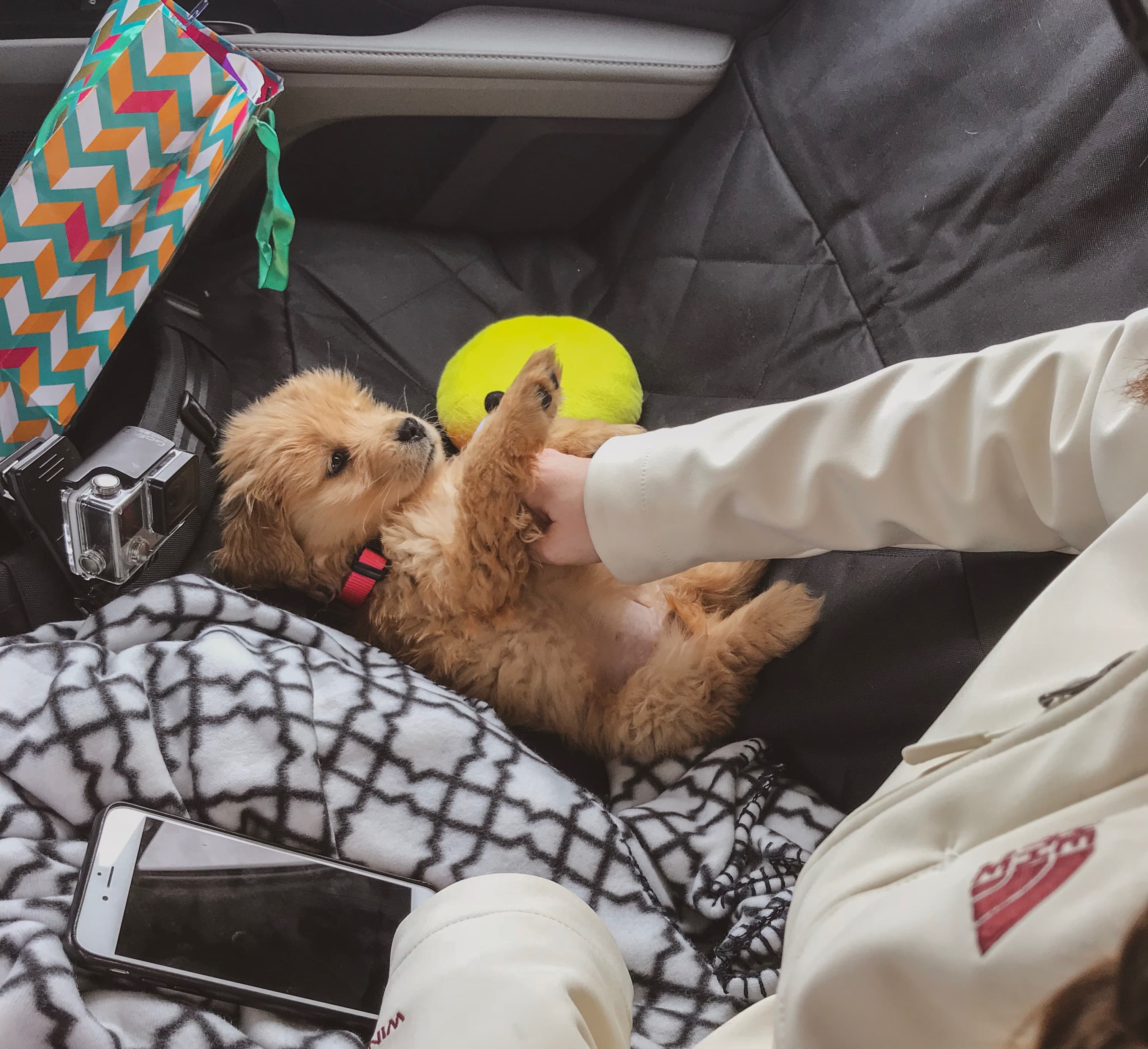
After years of waiting and months of preparation, my wife and I were finally able to welcome Lady, an 8-week old golden retriever, into our lives. As her first birthday approaches, I wanted to share some of our experiences and insight for anyone raising their own puppy.
If there’s a topic or technique you’re not familiar with, I recommend following the links I provided. I tried to provide a brief summary of the techniques we used without going into detail.
Table of Contents
- Preparation
- Responsibilities
- Resources
- Must-Have Items
- Preparing Your Home
- The First Few Days
- Socialization
- House Training
- General Training
- Surprises
- Recap
Preparation
Responsibilities
First, it’s important to understand what responsibilities come with owning a dog. Owning a dog means taking responsibility for another being’s happiness, safety, and health. It means being able to afford vet bills when your dog eats something it shouldn’t have, and always having a plan for his or her care when you can’t be around. It means being emotionally intelligent enough to realize your dog doesn't speak English, and doesn’t understand the phrase “stop chewing on the walls!”
Being a responsible dog owner also means training your dog to be a positive member of society. An untrained dog can be dangerous or even life-threatening.
Before bringing a dog into your life, please make sure you’re able to dedicate the necessary time and attention.
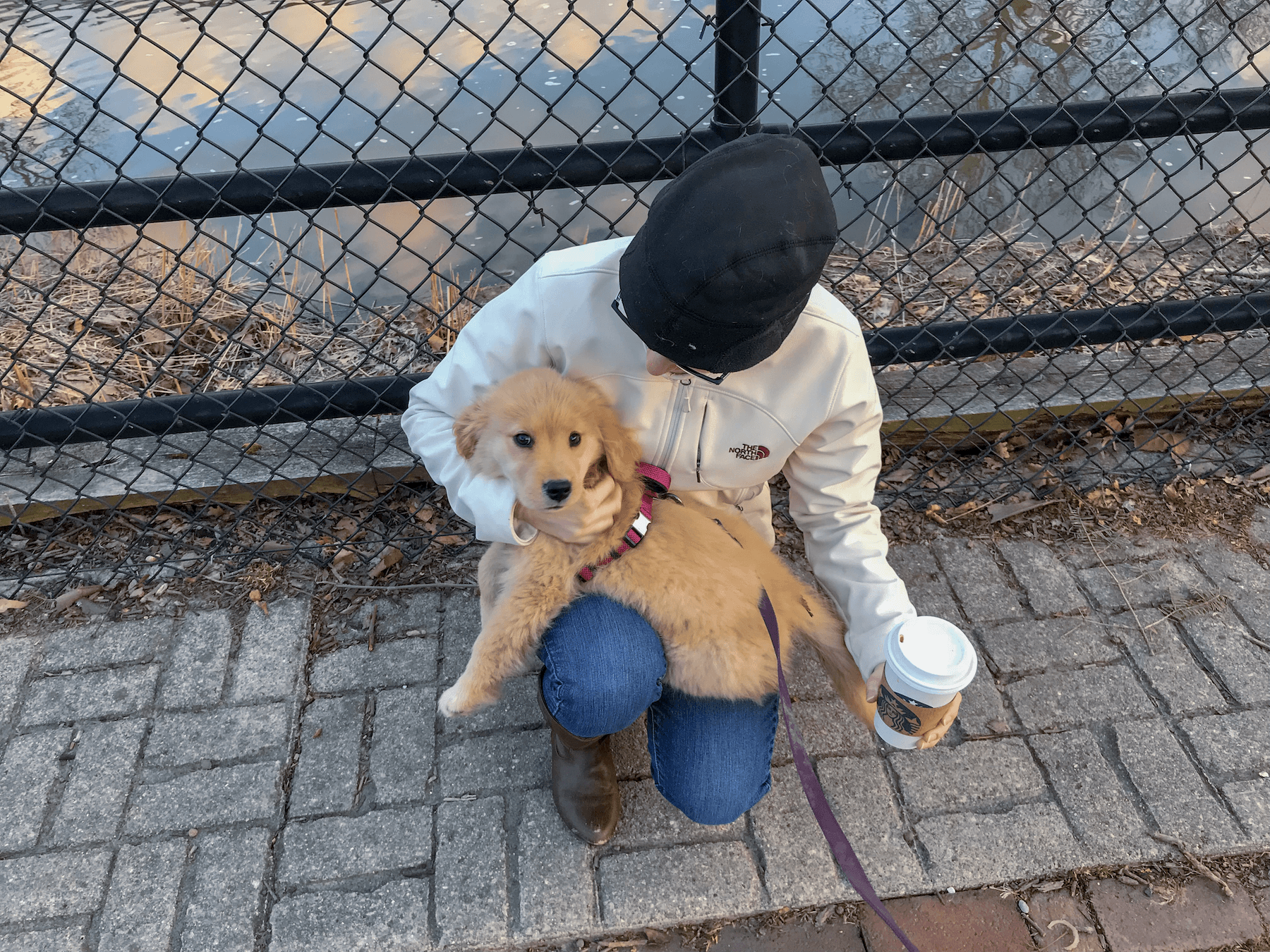
Resources
To help prepare us for owning a dog, my wife and I both read the following books. We would highly recommend them to anyone:
- The Other End of the Leash: Why We Do What We Do Around Dogs by Patricia B. McConnell
- The Power of Positive Dog Training by Pat Miller
- Before and After Getting Your Puppy by Dr. Ian Dunbar
After reading the above, we found some amazing dog trainers that do YouTube videos. Watching these videos helped us see training techniques applied in real-world scenarios with real dogs. These channels are our favorites:
And, last but not least: my wife and I are both avid Redditors. We found these subreddits to be super helpful:
Must-Have Items
There are some must-have items that need to be purchased before bringing home your puppy. Here are the things we bought beforehand:
- A dog harness let us take Lady out for walks and bathroom breaks without her running off into the sunset. A harness is better than a collar when your puppy is young because the tissue and muscles in their neck are still developing.
- A durable dog leash. If your puppy is smaller than 10 pounds, I would recommend one of the thinner leashes.
- Plenty of food for your growing puppy. It’s important to use the same brand of food your puppy has been eating or you risk an upset stomach. Don’t forget to get a food bowl and water bowl, too.
- Treats for training. It’s never too early to start.
- Lots of poop bags.
- Different types of toys to keep your dogs interest. You will need to monitor your puppy with these toys even if they appear safe.
- A crate if you decide to crate-train, which I highly recommend. Make sure to segment it off for your puppy’s size if they’re still growing into it!
- A comfortable bed for your puppy to rest on.
- Grooming supplies like a brush, nail clippers, shampoo & conditioner, towels,
- A form of identification like an ID tag and/or microchip.
- Cleaning supplies, including an enzymatic cleaner, which is invaluable.
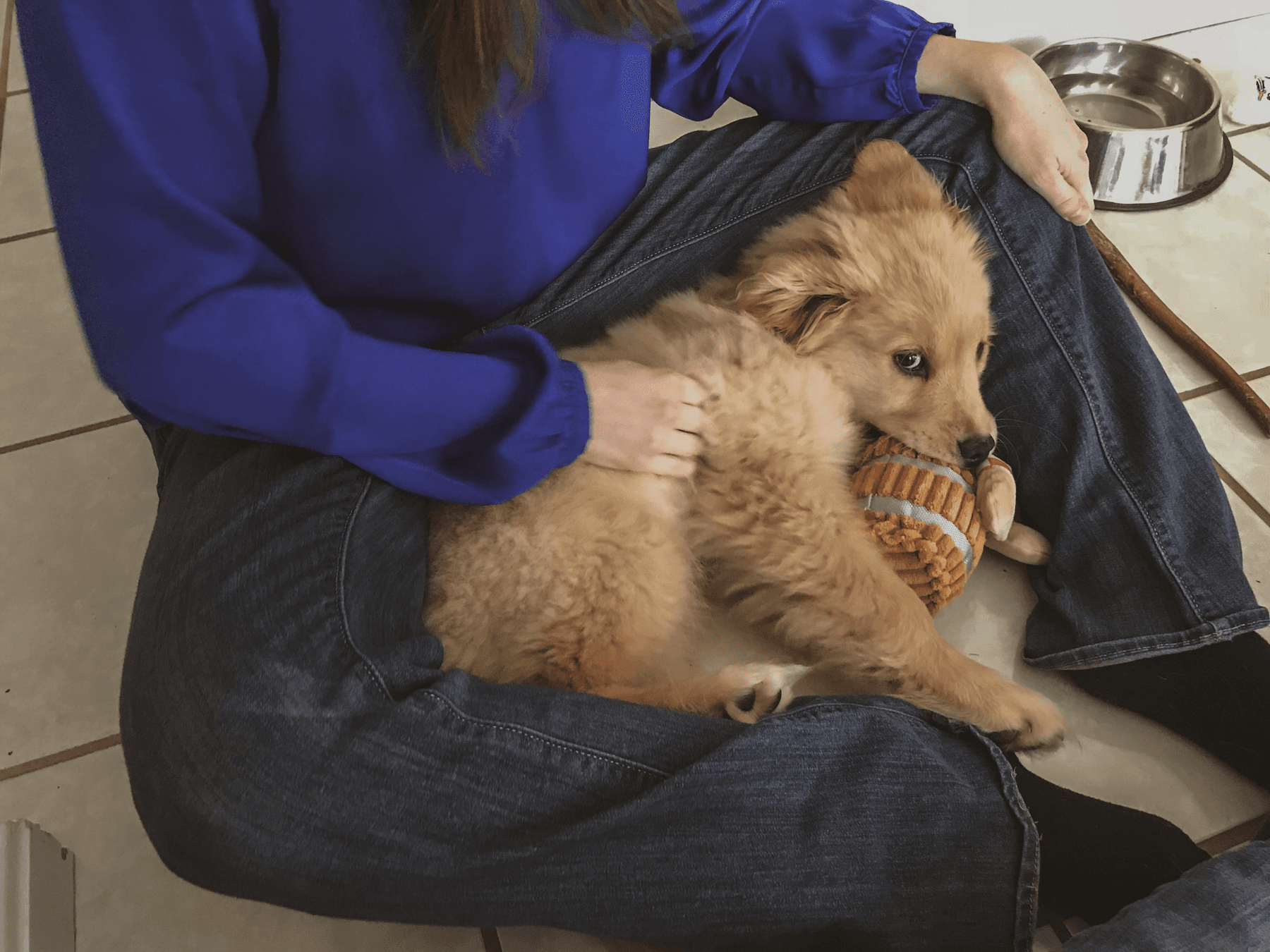
Preparing Your Home
We used baby gates to block off an area -- our kitchen -- for our puppy to roam free with supervision. We also made sure to remove any choking hazards, wires, and other unsafe objects. The cabinets all had baby-proof mechanisms on them, and the stove (which she couldn’t reach at the time) had protective knobs to prevent her from burning the house down.
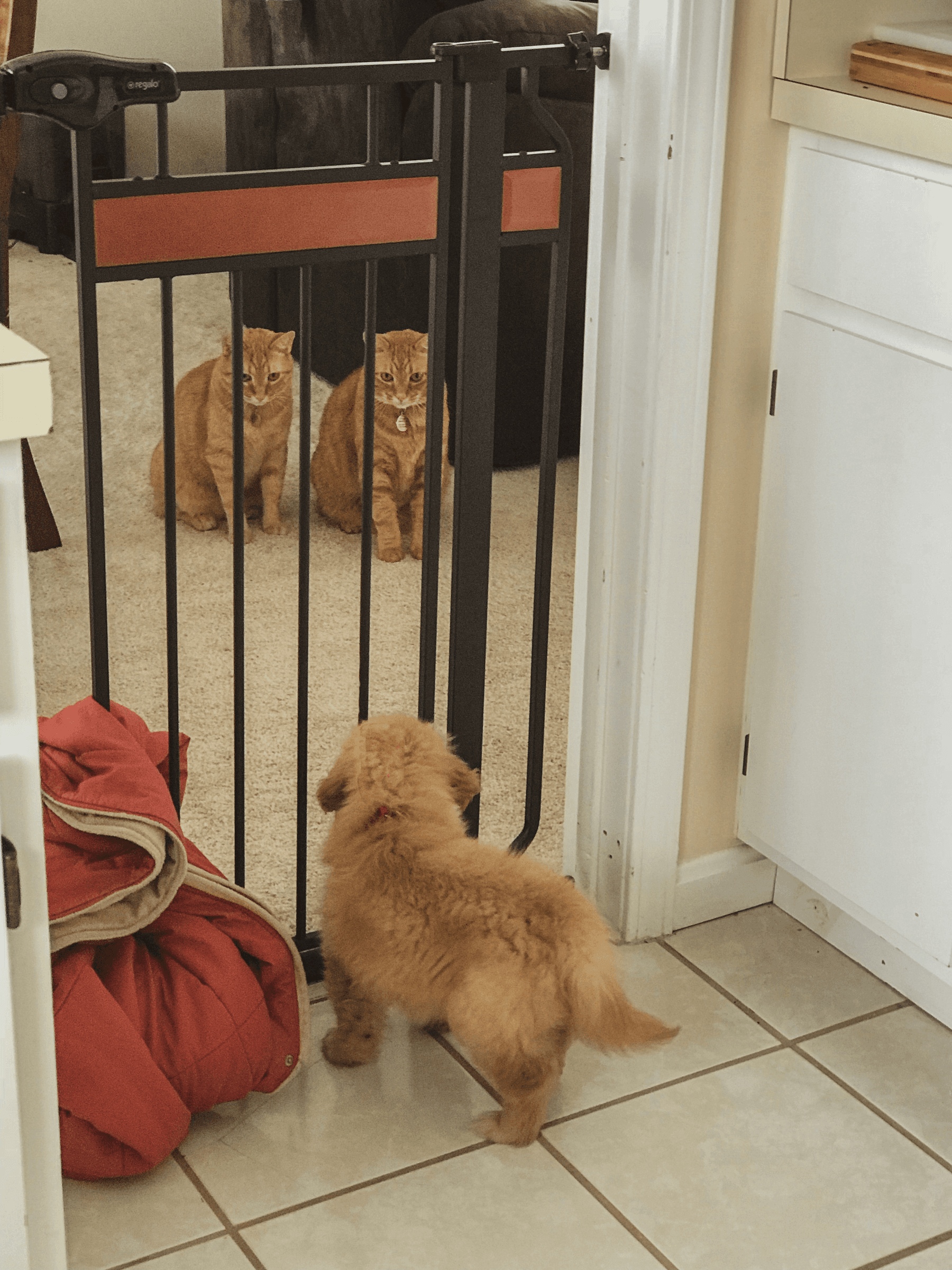
The First Few Days
We picked up Lady on March 2nd, 2018. She was 8 weeks old and had never spent a night away from her mother or litter mates. Our goal was to make the transition as smooth as possible for her.
When we got home, Lady would play and explore her surroundings until she tired herself out. She’d repeat this process throughout the day, over and over. We started getting her comfortable with her crate by loading it with treats and bribing her to climb into it. The goal was to make the crate as comfortable and inviting as possible, and for her to associate good things (treats, attention) with it. It paid off quickly - Lady was starting to nap in her crate (with the door open) more and more.
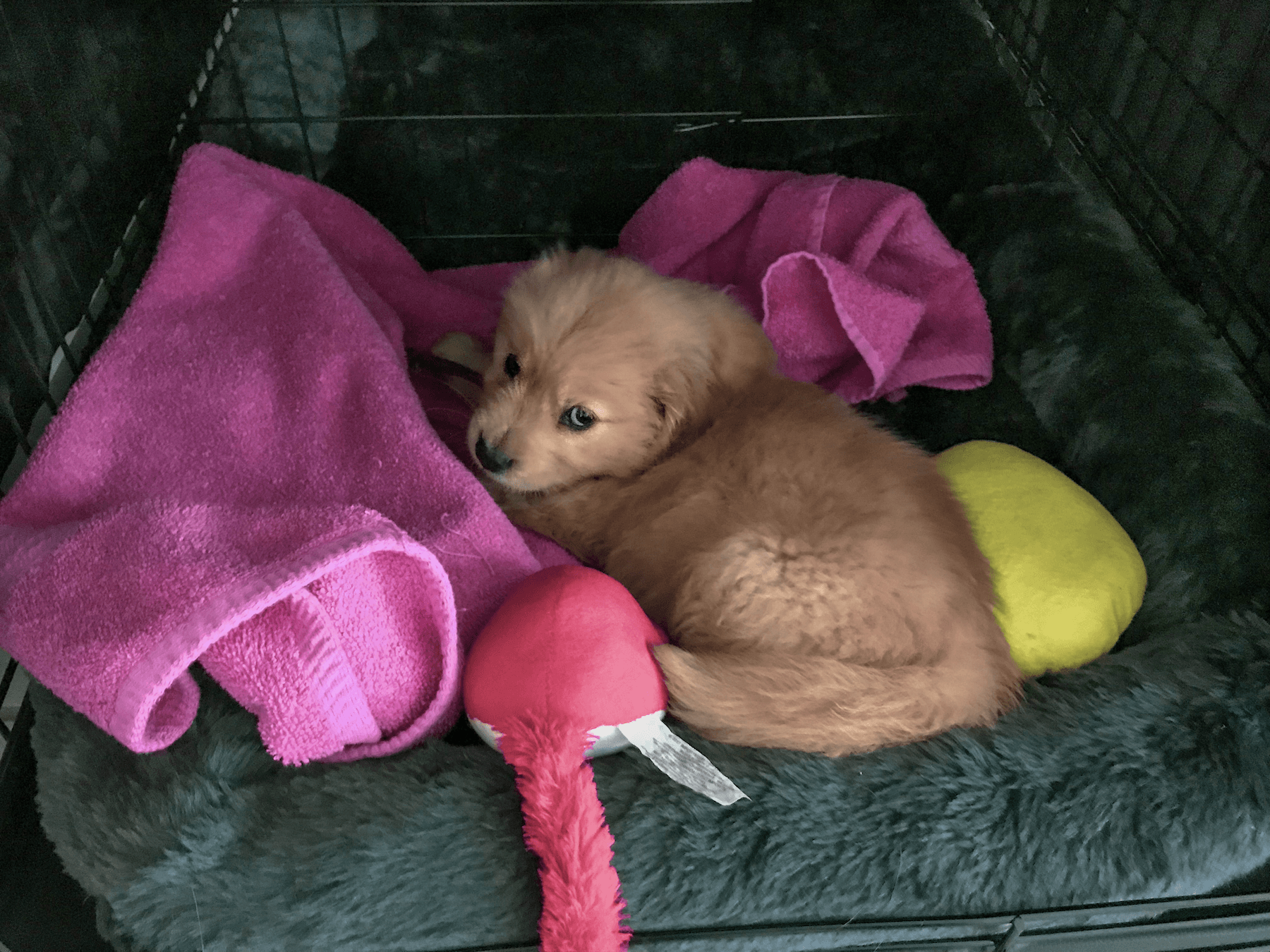
To help with her house training, we were taking her outside every hour. When she relieved herself outside, we’d act excited and give her a treat. She caught on very quickly that going outside meant good things happen. There were still accidents in the house, but usually they could be tied to things we could improve. Occasionally, we would forget that running around can stimulate her bladder, so she’d pee indoors after a play session. Or, when we went to take her out, we’d forget to put our coat on first, and she’d pee while we were getting ready. It’s important to keep in mind that, at this age, a puppy’s bladder is tiny.

Another thing we did to help her transition to her new home was to sleep on the floor next to her crate. I slept on her (extra large-sized) foam dog bed while she slept in her crate. Whenever she started to cry, I’d stick my hand in to comfort her. It calmed her down instantly, which helped her sleep. Each night I would sleep further away from her until I could sleep in a different room. Gradually, she learned that sleeping alone didn’t mean she was abandoned, and she stopped crying at night. After a few days of this, she was able to sleep through the night (minus pee breaks!)
Socialization
One of (if not the) most important things to consider when raising a puppy is socialization. Puppies need to be exposed to lots of different stimuli when they’re young. This means introducing them to other puppies, adult dogs, people, cars, bicycles, garden hoses, everything. Anything you don’t expose your puppy to might become something they’re fearful of when they get older. It’s important to understand that even if you are introverted, you need to socialize your dog.
Just as importantly, they need to be exposed in a way they sets them up to succeed. New experiences should be fun and full of treats, not scary. If your puppy reacts to something poorly, try giving them treats every time they look at it. Pretty soon, they’ll associate it with positive feelings and it’ll be their new favorite thing.
Starting when we brought Lady home, we brought her to downtown Chagrin Falls every single day. She was exposed to people, other dogs, cars, and all sorts of sights and smells. Between the age of 8 and 20 weeks she probably met over 300 people.
We also took Lady to puppy classes at Coldnose Companions, a dog training business near us, which had puppy play sessions. She had a blast and, more importantly, learned that other dogs could be a source of fun and not danger.
Socializing Lady had a profound affect on her personality and temperament as she grew up. It’s incredibly important that you socialize your dog as much as possible before the age of 16 weeks.
House Training
One of the most important things you can teach your new puppy is where to relieve itself. For Lady, as with everything we taught her, we used positive reinforcement techniques. We would take her out for bathroom breaks frequently — when she was 8 weeks old, that meant every hour she was awake — and reward her heavily when she relieved herself outside.
The technique for this is really important. We would say “yes!” and reward Lady immediately after she relieved herself. Our vet recommended rewarding her as she’s relieving herself, but we found she’d get too distracted and forget to finish. If you wait too long to reward your puppy, though, she won’t associate the positive feeling (the praise and treat) with the good behavior.
Lady caught on very quickly, and started sitting at the door when she needed to go outside. We kept up the rewards for the first several months, even after she consistently notified us when she needed to go.
We found crate training to be an absolutely critical part to house training. Dogs prefer not to relieve themselves where they rest, so they’ll hold it until they can get further away. We would put Lady in her crate at night and when we couldn’t supervise her. When she needed to relieve herself, she would start to whine or bark. At that point, we would immediately take her outside, and reward her heavily when she finished.
There were still a few indoor mistakes, but almost all of them could be attributed to our behavior and not hers. One mistake happened when the puppy was waiting for me to get my coat on, for example. The other happened when I didn’t take her out after she had a high-energy play session. Running around like a crazy animal tends to jostle their bladders!
If your puppy has an accident indoors, it’s important not to punish her. She won’t associate the punishment with the mistake, and you’ll degrade the bond you have with her. Even worse, she may associate relieving herself with angering you, which may trigger her peeing in hidden indoor spots when you're not around. Or, it may make her afraid to relieve herself when you’re present - even outdoors.
General Training
We’ve done near-daily training sessions with Lady since we brought her home. They only take around 10 minutes each, and they pay off immensely. We use clicker training and positive reinforcement to train her what she should do, rather than punishing her when she does what she shouldn’t do. When she starts doing something we dislike, we ask her to do something we like (“redirect” her), and give her a treat when she does.
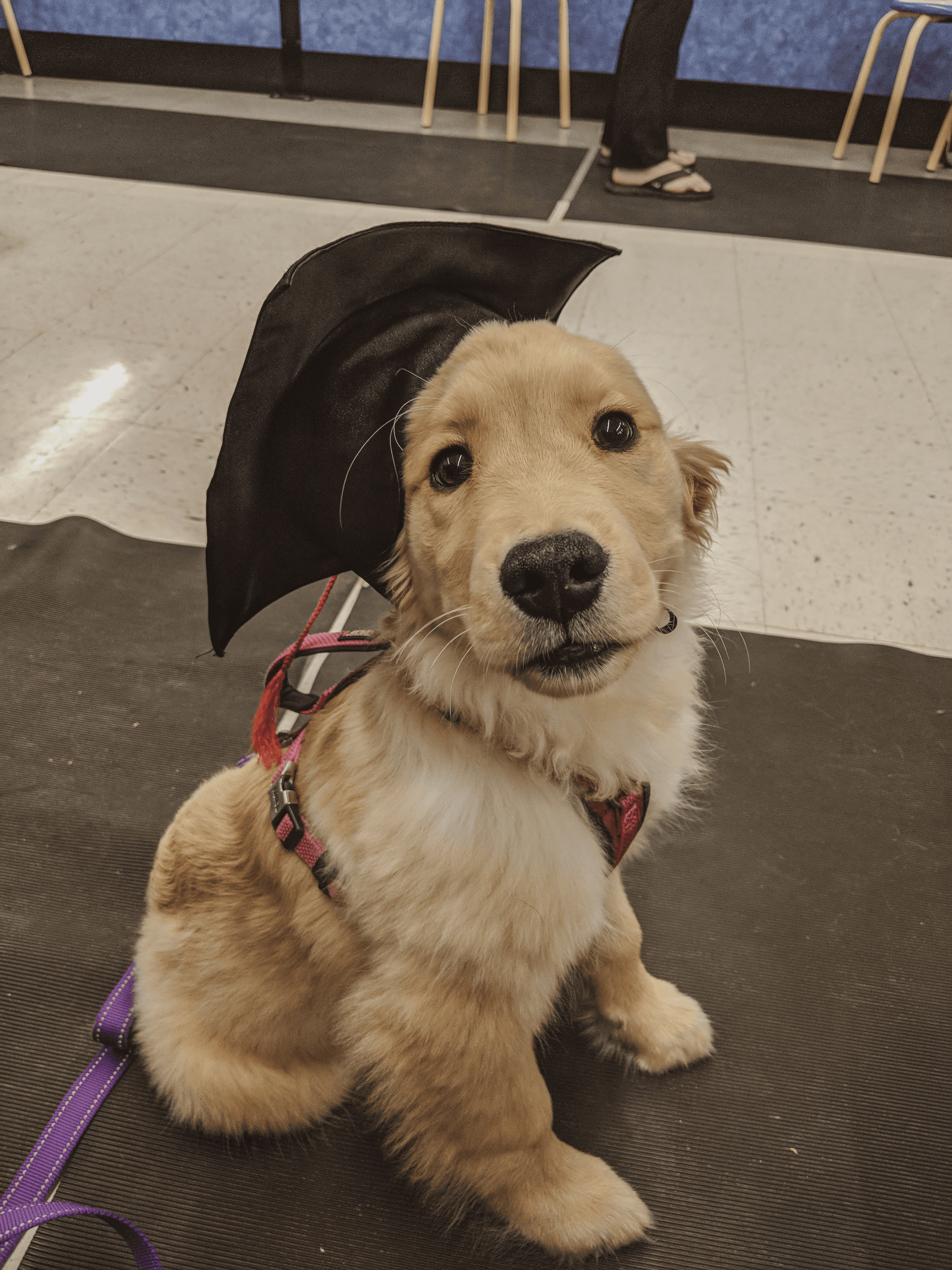
In our experience, this technique works really well. And, it influences her behavior when we’re not around. Conditioning her to feel good when doing the “right” thing makes her do the “right” thing even when there’s no sign of a treat.
The first things I would recommend training a new puppy would be: come, look, sit, leave it, and drop it. You can use any word for these commands, but I would recommend sticking to one or two words per command. A recall word (come) and a way to get your dog to drop anything in its mouth (drop it) could save your dogs life one day, so it’s important to train early.
We started by teaching Lady her name by “loading” it with the clicker. Loading a word involves saying it, clicking the clicker, and immediately giving your puppy a treat. Your puppy will very quickly associate the word with good things. Teaching Lady her name was helpful because she would immediately look towards us any time she heard it mentioned. We made sure not to share meaning across different commands, too - if her name meant “look at me”, we never used it to mean “come to me”, because that muddies the concept for her.
Our technique for teaching Lady was pretty standard positive reinforcement and clicker training. When Lady did something we liked (we “captured” the behavior we wanted), we would click and give her a treat. After a few occurrences of this, we’d start adding the English command (or “trigger” word) as she performed the behavior. Soon, Lady started associating the command with the behavior, which she’d gladly offer because she knew it meant treats.
We found it’s important not to repeat yourself. If you do, you risk your puppy learning that “come, come, come” means “come to me”, rather than the singular “come”. If you say the command once and your puppy doesn’t respond, wait patiently until she does. If she doesn’t, try again later. It’s also important to “proof” the command by practicing it with your puppy after they’ve learned it.
Surprises
My wife and I grew up with cats, so raising a puppy was a brand new experience for both of us. Reading the books from the Resources section of this post helped tremendously. We both grew up watching Animal Planet, which, unfortunately, featured Cesar Milan and his outdated (and cruel?) training techniques. The techniques we learned from these books set us -- and our puppy -- up for success.
With that being said, there were still some surprises that caught us off guard!
The first and biggest surprise was how important mandatory naps are. I assumed Lady would take a nap if she was overly tired, especially after a long play session. Instead, she enters a “cranky” state — similar to how toddlers get cranky when they haven’t had their nap — and would stop listening to commands. She would also get overly “bitey”, and pull at people’s clothes. If you put her down for a nap in her crate when she gets overly tired, she passes out immediately and wakes up a few hours later a totally new dog. Scheduling these mandatory naps has been a huge improvement.
The second surprise was that toys aren’t inherently interesting to Lady. For the most part, she will completely ignore her toys unless there’s a person making them exciting and playing with her. I had assumed she’d be excited to fetch a toy while I worked at my desk, but she gets bored almost instantly. That’s one of the downsides of having an incredibly smart dog: she gets bored easily. When she gets bored, I take her outside and exhaust her. As plenty of people have told us: a tired dog is a good dog.
Recap
As our puppy gets to one year of age, we are ecstatic about the type of dog she’s becoming. Training played a large role in this, including clicker training, positive reinforcement, and crate training. But, more important than any one technique, I think consistency was the key.
Hopefully, these techniques will help others who may be raising their own puppy. If you send me photos, I’d love to add them to this post!
